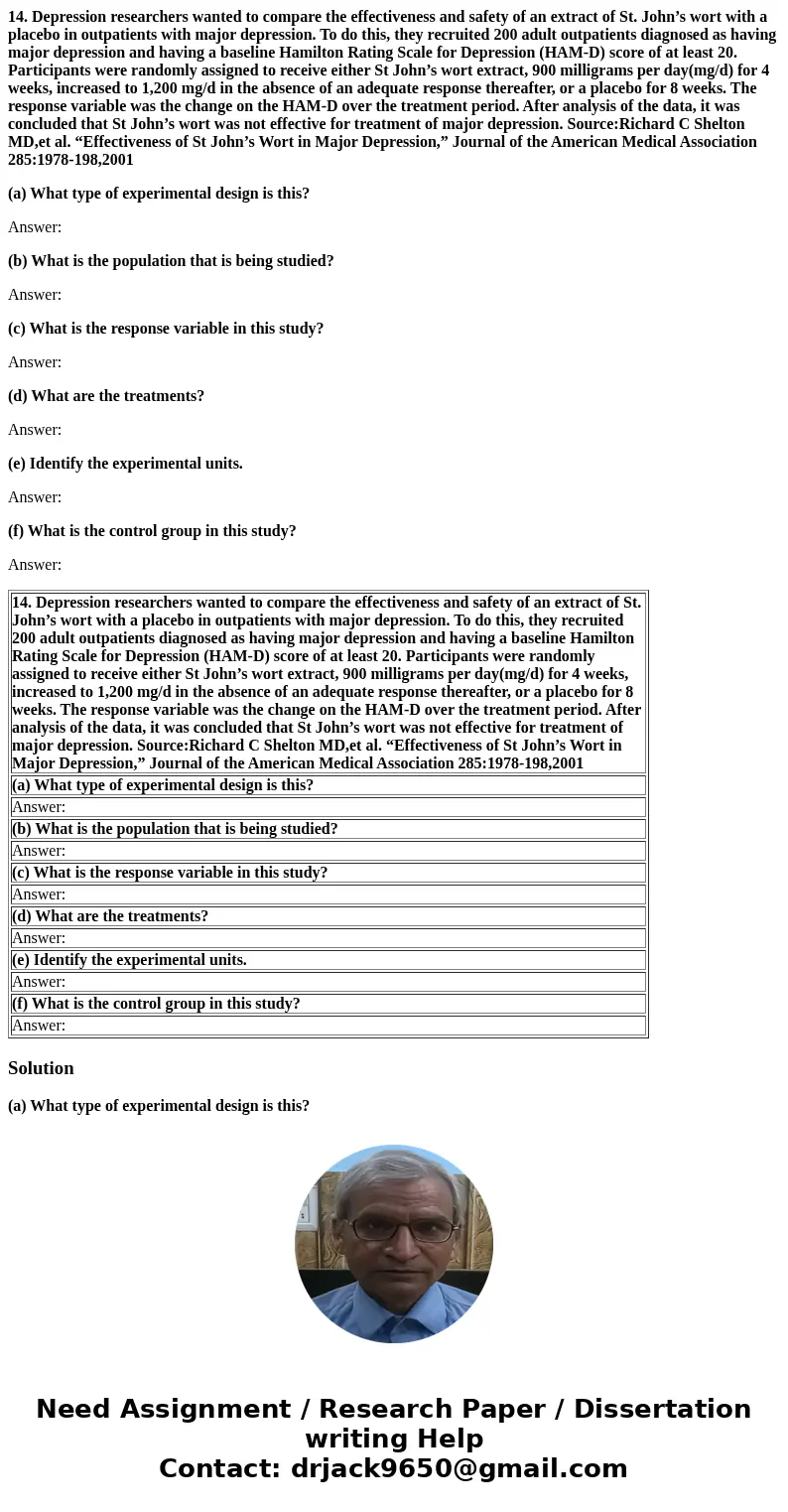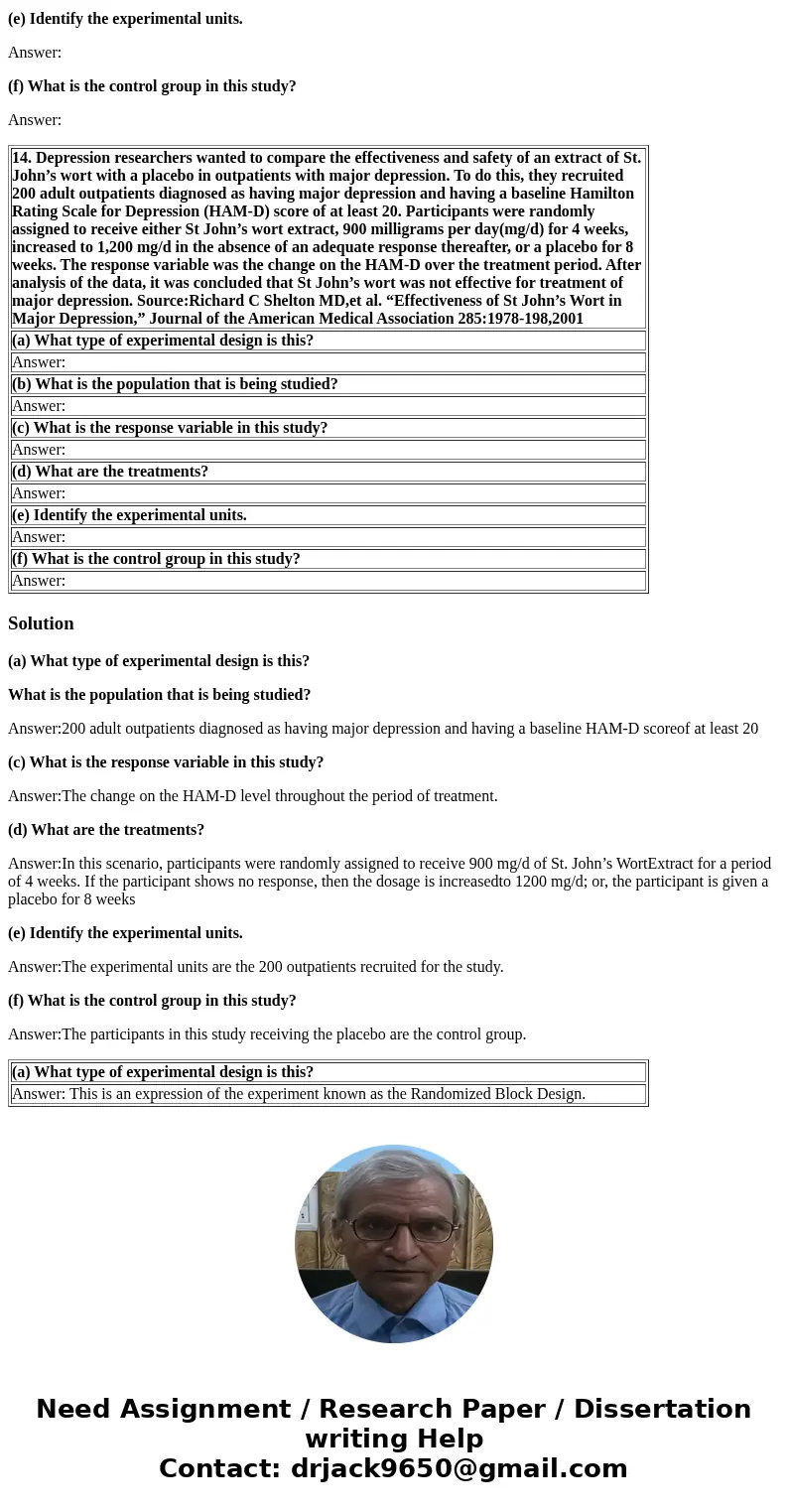14 Depression researchers wanted to compare the effectivenes
14. Depression researchers wanted to compare the effectiveness and safety of an extract of St. John’s wort with a placebo in outpatients with major depression. To do this, they recruited 200 adult outpatients diagnosed as having major depression and having a baseline Hamilton Rating Scale for Depression (HAM-D) score of at least 20. Participants were randomly assigned to receive either St John’s wort extract, 900 milligrams per day(mg/d) for 4 weeks, increased to 1,200 mg/d in the absence of an adequate response thereafter, or a placebo for 8 weeks. The response variable was the change on the HAM-D over the treatment period. After analysis of the data, it was concluded that St John’s wort was not effective for treatment of major depression. Source:Richard C Shelton MD,et al. “Effectiveness of St John’s Wort in Major Depression,” Journal of the American Medical Association 285:1978-198,2001
(a) What type of experimental design is this?
Answer:
(b) What is the population that is being studied?
Answer:
(c) What is the response variable in this study?
Answer:
(d) What are the treatments?
Answer:
(e) Identify the experimental units.
Answer:
(f) What is the control group in this study?
Answer:
| 14. Depression researchers wanted to compare the effectiveness and safety of an extract of St. John’s wort with a placebo in outpatients with major depression. To do this, they recruited 200 adult outpatients diagnosed as having major depression and having a baseline Hamilton Rating Scale for Depression (HAM-D) score of at least 20. Participants were randomly assigned to receive either St John’s wort extract, 900 milligrams per day(mg/d) for 4 weeks, increased to 1,200 mg/d in the absence of an adequate response thereafter, or a placebo for 8 weeks. The response variable was the change on the HAM-D over the treatment period. After analysis of the data, it was concluded that St John’s wort was not effective for treatment of major depression. Source:Richard C Shelton MD,et al. “Effectiveness of St John’s Wort in Major Depression,” Journal of the American Medical Association 285:1978-198,2001 |
| (a) What type of experimental design is this? |
| Answer: |
| (b) What is the population that is being studied? |
| Answer: |
| (c) What is the response variable in this study? |
| Answer: |
| (d) What are the treatments? |
| Answer: |
| (e) Identify the experimental units. |
| Answer: |
| (f) What is the control group in this study? |
| Answer: |
Solution
(a) What type of experimental design is this?
What is the population that is being studied?
Answer:200 adult outpatients diagnosed as having major depression and having a baseline HAM-D scoreof at least 20
(c) What is the response variable in this study?
Answer:The change on the HAM-D level throughout the period of treatment.
(d) What are the treatments?
Answer:In this scenario, participants were randomly assigned to receive 900 mg/d of St. John’s WortExtract for a period of 4 weeks. If the participant shows no response, then the dosage is increasedto 1200 mg/d; or, the participant is given a placebo for 8 weeks
(e) Identify the experimental units.
Answer:The experimental units are the 200 outpatients recruited for the study.
(f) What is the control group in this study?
Answer:The participants in this study receiving the placebo are the control group.
| (a) What type of experimental design is this? |
| Answer: This is an expression of the experiment known as the Randomized Block Design. |


 Homework Sourse
Homework Sourse